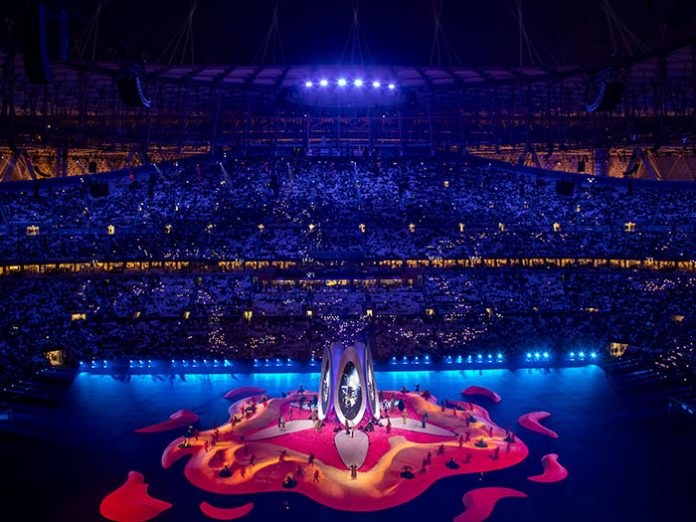The opening ceremony of the AFC Asian Cup at the Lusail Stadium in Doha, Qatar, on 12 January 2024 was a feast for the eyes thanks to the lighting design by Roland Greil and his team.
The brief was to develop an overall theatrical design that not only provided the visual spectacle of a huge stadium show but also fulfilled all the requirements of a 360° broadcast. In collaboration with Technical Director Shannon Gobell, Greil succeeded in creating a rig that satisfied the complex requirements.
Greil chose a grandMA3 system to control the lighting. This consisted of four grandMA3 full-size consoles for the production and four grandMA3 light as mobile consoles in the stadium, supported by twelve grandMA3 processing units XL. In addition, a further three grandMA3 full-size consoles were used for preparatory work at the previs studio.
“The full redundancy as well as the incorporation of the remote consoles into the network were particularly important to us as it allowed us to operate from several different locations within the stadium. And for a show of this magnitude, the multi-user capability of the lighting consoles is indispensable, as we work with several programmers in these cases so that we can manage the workload in the given time,” explained Greil.
The opening ceremony of the AFC Asian Cup marked the first use of a grandMA3 system by the team around Greil. “Having a high-performance platform was of enormous importance for this project, enabling us to deal with the complexity and the vast number of different requirements,” continued the designer. “Equally important were reliability as well as operating successfully within a larger network infrastructure.”
The idea was that the lighting design would mainly function as a “canvas” for the set designed by Visual Creative Director Sila Sveta as well as supporting the visual storytelling with a virtual frame made from light.
The programming for the show was performed by Michael Kühbandner and Markus Neubauer, using grandMA3 software version 1.9.7.0. While Kühbandner referred to “flexibility, consistency and practicality” as the main plus points of the software, Neubauer gave a more detailed description of the positive features that impressed him most during the course of the programming: “We were able to create complex motion sequences very quickly with the aid of phasers and it was possible to adapt them perfectly for the cameras during the rehearsals. And in a situation where time constraints forced us to work simultaneously on pre-production as well as presets in the stadium, we were able to synchronise our presets and sequences continually by means of data pools although we were programming in two different environments at the same time. Not to forget the MIB timings per cue. To avoid making some trusses ‘sway’, I used differentiated MIB fade times for different cues. That would not have been possible with a grandMA2 system. Generally, I like the fact that you can now do a lot more work on the stage and need to focus less on the console because in the case of phasers, for instance, you see immediately what you are programming.”
Neubauer mentioned the selection grid function first and foremost: “Thanks to the selection grid, we were able to align all the phaser and delay times in the 360° stadium show precisely and do so with a single group selection – although we had trusses with different numbers of lights.”
Kühbandner agreed: “The selection grid definitely saves a lot of time as regards grouping, effects as well as the setting up of the lights. In conjunction with the new MAtricks window with delay times and the Mirror Grid option, it is a very powerful tool. But what also helped speed up my work considerably were the multi-touch displays. In conjunction with the possibility of setting the screen areas to be larger than the screen resolution, you are simply much quicker, for instance when you can arrange less frequently used pools and elements at the edge and can simply move things using three fingers rather than actually changing the view.”
“And the swipeys for important functions such as Label/Copy/Move/Store etc. save no end of keystrokes and gestures – and therefore time,” he continued. “I also like the tree structure, which was introduced for the entire system, and the associated restructuring of many areas. Being able to simply expand sub-objects rather than having to search for them in other windows makes it much easier to keep an overview, which saves me further time.”
Roland Greil added: “In interaction with Vectorworks and Depence, we also made use of GDTF and MVR, making our entire workflow more efficient.”
“The AFC Asian Cup Opening Ceremony in Doha was a special project for us all. In collaboration with an excellent team, we created an enchanting theatre show of stadium magnitude with sophisticated scenery on the pitch immediately prior to the opening match of a major football tournament. You don’t do that sort of thing every day, and I’m proud of our work and the result. The decision to work using a grandMA3 system for the first time for this project proved absolutely the right one,” the designer concluded.





